Lithops (LIH-thups) are a fascinating group of succulents that look like scattered rocks in their native southern Africa. They are commonly called living stones, flowering stones or rock plants. By mimicking the look of stones, lithops escape the notice of foraging animals. This same, humble appearance is fascinating to growers who quickly develop a love/hate relationship with these plants until they learn to understand them. Read on to learn all about these botanical gems, their life cycle and the specifics of lithops care.
Complete Lithops Care Guide
In this Post We'll Cover:
{Please note, some links in this post may be affiliate links to sites that pay me a small commission if you click on the link and make a purchase. This commission is at absolutely no cost to you. I only recommend products and companies that I have worked with and truly love! ~Kat}
Surely no succulent variety is killed so often as living stones. These cute little “butts” as they affectionately called will quickly die if you do not follow their very specific water requirements religiously. No kidding � a single, small drink in two months will kill your lithops if it happens at the wrong time. Yet they make charming house plants that will live 40-50 years. It’s not that they are harder to grow than other succulents, but they do have a peculiar life cycle you must understand. Take the time to get to know these fun little plants for years of rewards. Brace yourself for a long post!
What are Lithops? Living Stones
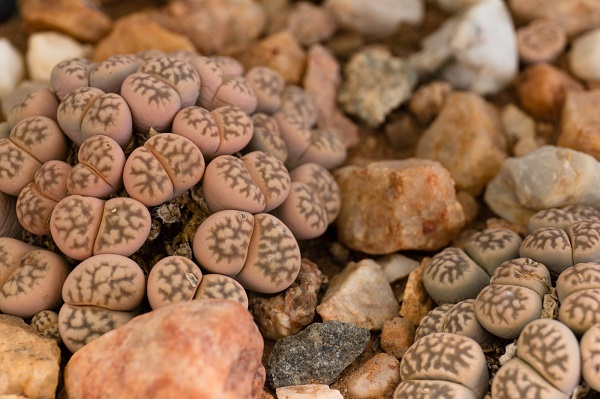
Lithops (the name is both singular and plural) are among the strangest plants known to man due to their extraordinary adaptations to the hot, dry climate of southern Africa to which they are native. A complete plant is formed by just two pudgy leaves that fuse together at their base and share a single long tap root. There is no stem. Like some Haworthia, lithops grow partially underground, to protect their leaves from drying out too quickly in the harsh sun. They form “leaf windowsLeaf windows are specialized leaf structures specific to som... More”, or translucent structures on the top of their two leaves that allows sunlight to penetrate deep inside the plant to reach chlorophyll-rich internal cells to complete photosynthesisPhotosynthesis (FO-to-SIN-thuh-sis) is the process plants us... More.
Lithops varieties grow in a wide range of colors including green, brown, grey, pink, tan, blue, purple and red, varying with the region in which they grow. They are part of a larger group of succulents with an uncanny resemblance to rocks called mesembsSucculent members of the Aizoaceae family that resemble ston... More. See the grooves on top of the leaves, and the colored speckling on each? Flowering stones mimic not just the look of surrounding rocks, but even the ground in their native region, from limestone to sandstone to granite. The grooves and markings on each leaf are unique. This camouflage is effective at keeping lithops hidden from hungry and thirsty animals. Often, even botanists searching for them in their native land will overlook them.
Lithops top out at just 2 inches tall. Consider the environment from the perspective of our little lithops. The blazing heat and dry conditions are so profound, any more than two short leaves and a single tap root would be an extravagance.
Lithops Flowers – Flowering Stones
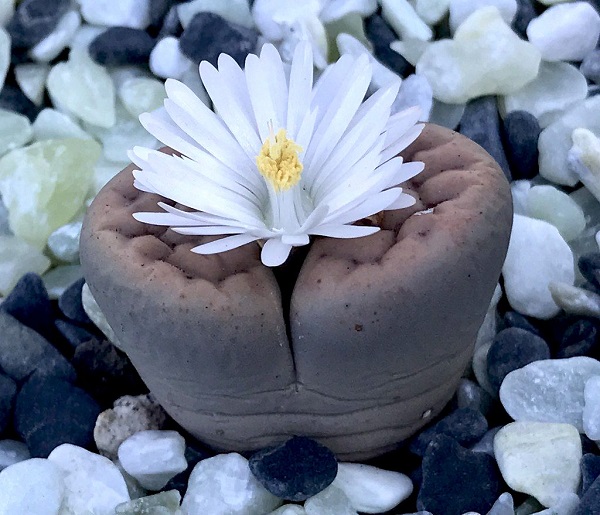
Once they are 3-5 years old, Lithops bloom reliably, producing a frilly, daisy-like flower in white, bright yellow or orange, large enough to cover the little plant. The flowers last for up to a week and often have a sweet, spicy fragrance that beckons to bees � their favorite pollinators. Living stones are not self-fertile. They require outcrossing with another lithops plant, so pollinators are critical to their propagation in the wild.
Are Lithops Toxic to Pets?

Lithops are completely non-toxic and safe for pets and children. In Africa, children reportedly gather and feed on Lithops when thirsty.
This symbol denotes pet-safe succulents. For more information about succulents and pets, just click on this image anywhere on this site.
This symbol denotes pet-safe succulents. For more information about succulents and pets, just click on this image anywhere on this site.
Lithops Care
Living stones are more complicated to grow than other succulents. Not exactly harder, but there is much more to remember. Understanding the lithops life cycle, its specific needs and paying close attention to your plant are critical to good lithops care. With the following information, you’ll be able to make it happy indoors or out for years.
Lighting for Lithops
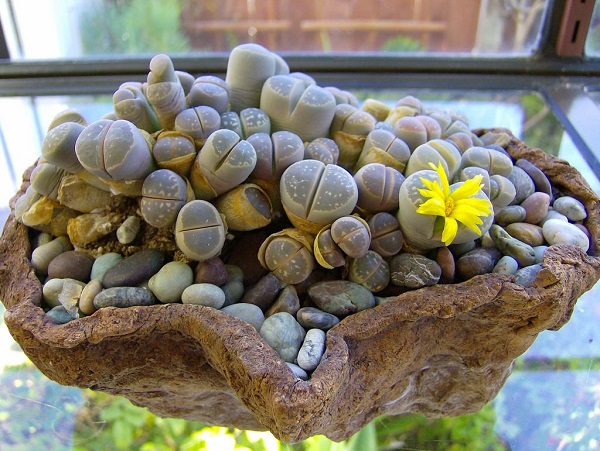
Lighting is an essential part of lithops care. Ensure your living stones get 4-5 hours of direct light each day. Outdoors, this can be morning or afternoon sun, with some protection during the heat of the day. Indoors, lithops will thrive with bright light from a south-facing window for a good 5 hours a day, or you can supplement their light with artificial lighting or a grow light for succulents.
Without good lighting, flowering stones will stretch, reaching for more light, and become etiolated. With no stem, advanced etiolation can become deadly. If you catch this condition � and address it with more light � you can save the plant. But take care not to increase lighting too much, too quickly, or it will sunburn, which can scar your plant. With new lithops you have just purchased, set them in bright, indirect light indoors and slowly acclimate them to more.
Temperature for Lithops Living Stones
Protect lithops from temperatures dropping below 50�F (10�C). If you have it growing near a window, move it further into the room over the winter to avoid it experiencing too severe a drop in temperature during the winter.
Lithops Soil
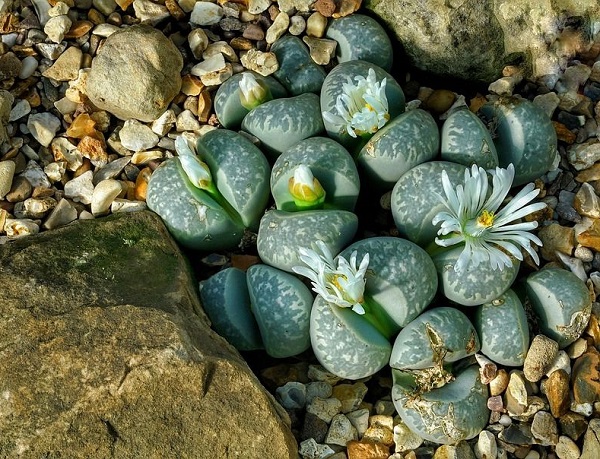
The right soil is a critical part of lithops care. While all succulents need fast-draining soil, lithops need super-duper FAST-draining soil. Whether you make your own succulent soil or use a pre-packaged blend, plan to cut your mix 50/50 with additional inorganic matter like pumice or turface (calcined clay) to increase the drainage. Better yet, plant in straight pumice or turface or a mix of the two. Given lithops extreme sensitivity to over-watering, this is an excellent approach, especially in humid climates.
Lithops Pests
In general, insects seem to overlook flowering stones as much as herbivores do, but there are still some pests that can become a problem. Watch for signs of spider mites, mealybugs or aphids. These insects can be removed with Safer insecticidal soap or treating them with isopropyl alcohol on a Q-tip. Just be sure to spray the succulents when they are out of direct sun. Then, give them 24 hours out of the sun before moving them back to their regular spot. My favorite method of insect control is to prevent them from bothering the plant in the first place with worm castings. Simply mix dry worm castings into the soil at the time you plant your flowering stones, or sprinkle them on the soil of established plants.
Now that you now the importance of lighting, pest-prevention and the right soil for lithops care, let’s tackle the crucial combo of lithops life cycle and watering…
Lithops Life Cycle & Watering
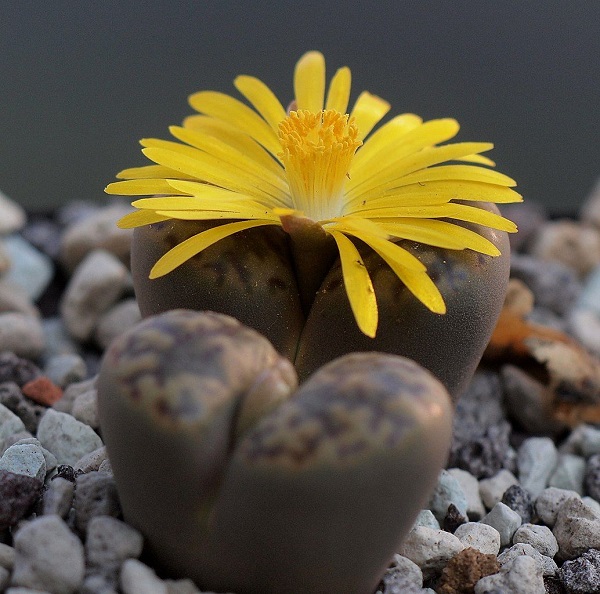
If you have ever killed a lithops living stone — you have a lot of company. Lithops care is not like that for any other succulent I know. Proper watering for succulents is a sure-fire way to kill a living stone. It is absolutely critical to water flowering stones according to their rather peculiar life cycle. However, once you understand this cycle, you’ll find it easy to keep your lithops happy. I promise! 🙂
How often your flowering stones need water will vary based on the plant, your soil, humidity, etc. Some are happy with just 4 waterings each year, some may want as many as 10 or 12. I cannot tell you how much water your lithops will need. What I can tell you is when not to water, when to water and how, based on the time of year and your lithops behavior:
Summer – Very Little Water!
In summer, lithops go dormant, resting during the heat of summer just as they do in their native habitat. Leave them dry during their summer dormancy. If you see the leaves become deeply wrinkled — and only if — give a single, small drink of water to replenish them. Aim to wet just the top 1/2 inch of the soil. Then let the soil dry completely again.
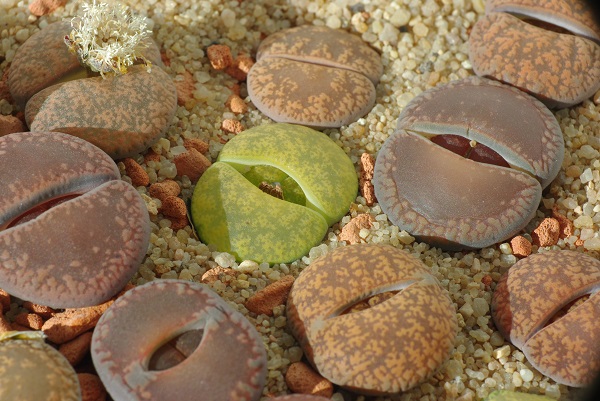
Fall – Water Well
In late summer to fall, after the heat of summer breaks, rains come to southern Africa and lithops begin to wake up. You’ll see the dividing line between the leaves begin to deepen and widen, as shown above). If it is mature enough to bloom, you’ll see the flower stem and bud emerge. When you see your plant waking and changing, with the dividing line deepening, give it a good, deep watering. Water so it runs from the drainage holes. Then let the soil dry completely. Then provide another thorough watering.
Once the flower is spent (if the plant is mature enough to bloom) the fissure between the leaves continues to widen as two new leaves develop from the center of the plant. Taper off on the water at this time.
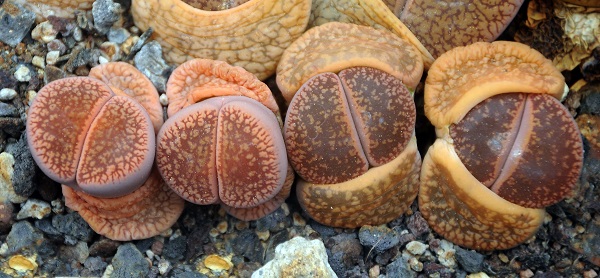
Winter – NO Water!
During the winter, lithops continue to grow, but in an odd fashion. The newly emerging leaves drain the nutrients and moisture from the established leaves, growing larger by cannibalizing the older leaves. You’ll see the new leaves growing larger as the mature leaves collapse and fall away. The tap root is not responsible for nourishing the plant at this time and is essentially dormant. Do not water lithops in winter.
It is crucial that you do not water during the winter. No water — none at all! No matter how wrinkled, shriveled and sad those leaves look, that is what is supposed to happen. Leave them attached and do not water.
Spring – Water
By spring, the mature leaves will be completely consumed, leaving nothing but dry, papery husks. It is now safe to remove the spent leaves and resume watering. Water just lightly at first, gradually increasing to a thorough watering, allowing the soil to dry completely between each watering. At this stage, the plant may begin to divide, forming a separate pair of leaves. Eventually, a pair becomes a small cluster of pairs. Throughout the spring, the new leaves will continue to grow larger and fuller, before again going dormant in the summer. As spring fades, taper off the watering, and leave the soil dry during the summer.
When in doubt – do not water. Pay attention to the changes you see in your plants as well as the time of year. If you’re not sure, skip the watering. And if you suspect you have over-watered lithops, dig them up and check the roots. Like saving any succulent from over-watering, get the roots out of the wet soil.
Planting Lithops
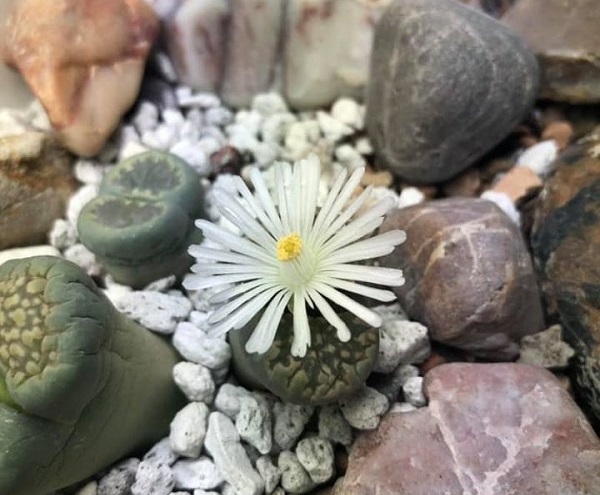
Lithops need sufficient room for their long tap root to reach without wrapping under. Provide a pot 5-6″ deep to allow room for the root. Much deeper and the pot will hold too much excess water in the soil the taproot cannot reach. Fill the pot with your mix of 50/50 succulent soil mixed with pumice or turface, or fill it with just pumice, turface or a mix of the two inorganic ingredients. Plant your lithops at irregular intervals, poking a hole deep enough to accommodate the tap root. Backfill with your soil or pumice mix. Gently tamp down the soil or pumice mix to eliminate air pockets. – Many thanks, Krissy Detering, for the use of this lovely photo!
DO NOT WATER your lithops when you plant it unless you are transplanting in fall or spring and it is showing clear signs of active growth.
As you can see from the many examples on this page, lithops look their best surrounded by the rocks, pebbles and stones they resemble. It’s hard not to feel they are happier among friends like this. Top dress the soil with pea gravel or succulent top dressing.
Planting Multiple Lithops in One Pot
Remember that different lithops plants may develop at different rates, with some still dormant while others are waking. This is a complication of planting more than one flowering stones in a container. Offset the problem by planting in an inorganic mix of pumice and turface for super fast drainage. Don’t mix lithops with other succulents or even cactus or you’ll wind up damaging both types of plants when you water.
PropagatingPropagating (PRAH-puh-gate-ing) a plant is to grow another p... Lithops
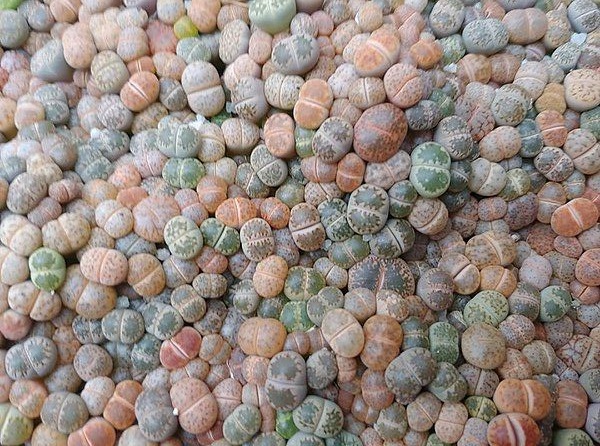
Although you’ll occasionally be able to divide a lithops clump, they are primarily propagated by seed. The seeds are long-lived, retaining their viability for well over a year or more with little care. Imagine a seed dropped to bare earth in a southern African drought � it may wait months for a trace of moisture before it can germinate. So it’s easy to find healthy, viable seeds, and they germinate well and reliably.
In the summer, fill a tray with clean, fine grain sand. Sprinkle lithops seeds over the sand and cover them with just a dusting of sand. Mist with water, and set the tray in a warm, well-lit spot. Keep the sand moist, but not wet. The first seedings should appear in a few weeks to a few months. Not all will germinate at once, with some stragglers taking over a year. Once you see rapid growth, back off on the water until the top 1/4 inch of sand dries out. When the seedlings are 2-3 months old, allow them to thoroughly dry between waterings, gradually increasing the dry times. Gently transplant the young lithops in the spring.
Where to Buy Lithops Plants and Seeds
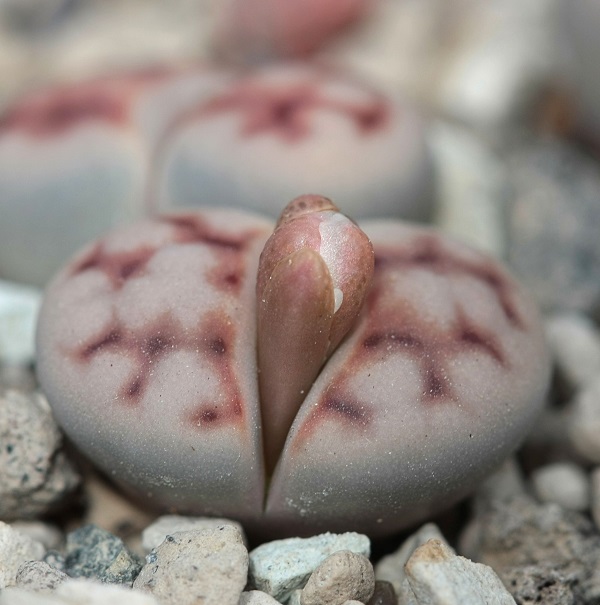
Hopefully, the intricacies of lithops care and the length of this blog post haven’t scared you off growing these little gems! They’re actually tough little plants that are quite tolerant of being shipped. The Succulent Source offers an excellent range of lithops varieties and sizes, most named, some the exact potted plants posted in the online picture and some a random mix. All are shipped as rooted, growing plants. You’ll find six different, named varieties of lithops living stones available as rooted, potted plants at Leaf & Clay. Mountain Crest Gardens offers an unnamed mix of rooted, potted living stones. And Amazon sellers offer a number of mixed lithops plants as potted plants or bare root as well as mixed sets of seeds.
I hope this looong post makes you feel empowered to try growing living stones, and not turned off forever! 🙂 I would love to know � have you tried growing lithops in the past, are you now or do you plan to? With proper care, they are easy to please and fun to grow. Enjoy!
You can do this!

P.S. For more succulent information and care, be sure to subscribe! You�ll receive my FREE e-course, 7 Steps to Succulent Success!
P.P.S. Why not join my Facebook Group for succulent lovers? We talk about succulent care, propagation, succulent identification, and design. It’s a warm and welcoming group that would love to meet you!
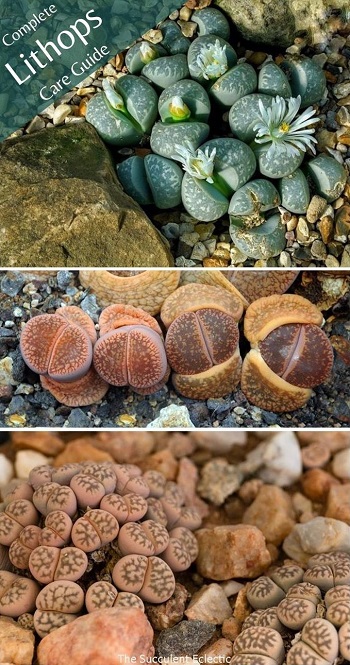
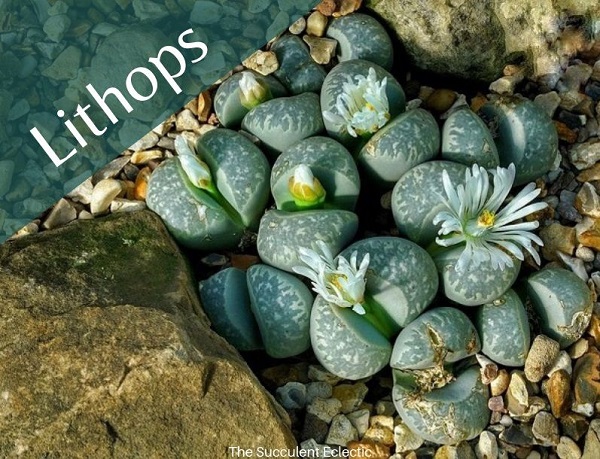

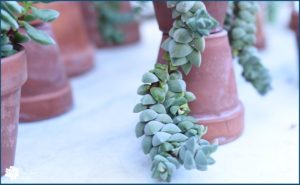
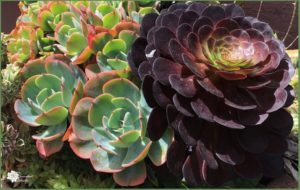
Awesome post!! i like lithops very much, and i already killed one by watering it at the wrong time.
i purchased some on line a month ago, they seemed doing well at the moment; this time i will follow your instructions. Thank you so much.
Hi Michiko,
Such intriguing little plants, aren’t they? And easy-peasy to grow, so long as you know the secret to their timing.
Enjoy!
~Kat